Peugeot 407 C 2008 Owner's Manual
Manufacturer: PEUGEOT, Model Year: 2008, Model line: 407 C, Model: Peugeot 407 C 2008Pages: 211, PDF Size: 11.74 MB
Page 111 of 211

8
100
VISUAL AND AUDIBLE FRONT AND/OR REAR PARKING ASSISTANCE
This system consists of proximity sen-
sors:
- six in the front bumper,
and/or
- four in the rear bumper.
It detects any obstacle (person, vehi-
cle, tree, gate, etc.) in front of or be-
hind the vehicle. However, it cannot
detect obstacles located directly under
the bumper.
An object, such as a stake, cone or any
other similar object may be detected
at the beginning of the manoeuvre but
may no longer be detected when the
vehicle comes close to it. The proximity of the obstacle is indi-
cated by:
- an audible signal which becomes
more rapid as the vehicle ap-
proaches the obstacle,
- a graphic on the multifunction dis- play, with blocks which become in-
creasingly close to the vehicle.
The obstacle is located in relation to
the emission of the audible signal by
the speakers; that is, front or rear and
right or left.
When the distance between the vehi-
cle and the obstacle is less than ap-
proximately thirty centimetres, the
audible signal becomes continuous
and/or the "Danger" symbol appears
on the multifunction display.
The system becomes inactive again:
- when you exit reverse gear,
- when the speed is above 6 mph (10 km/h),
- at the end of the manoeuvre, when stationary, after a few seconds
(front parking assistance only).
Detection zone
To guarantee optimum opera-
tion, in bad weather or in win-
ter, ensure that the sensors
are not covered with mud,
frost or snow. The system is deactivated if
the vehicle is stationary for
more than 3 seconds.
Detection
The system is activated when:
- reverse gear is engaged,
-
the speed is below 6 mph (10 km/h)
in forward gear.
It is accompanied by an audible signal
and/or displaying of the vehicle on the
multifunction display.
Page 112 of 211
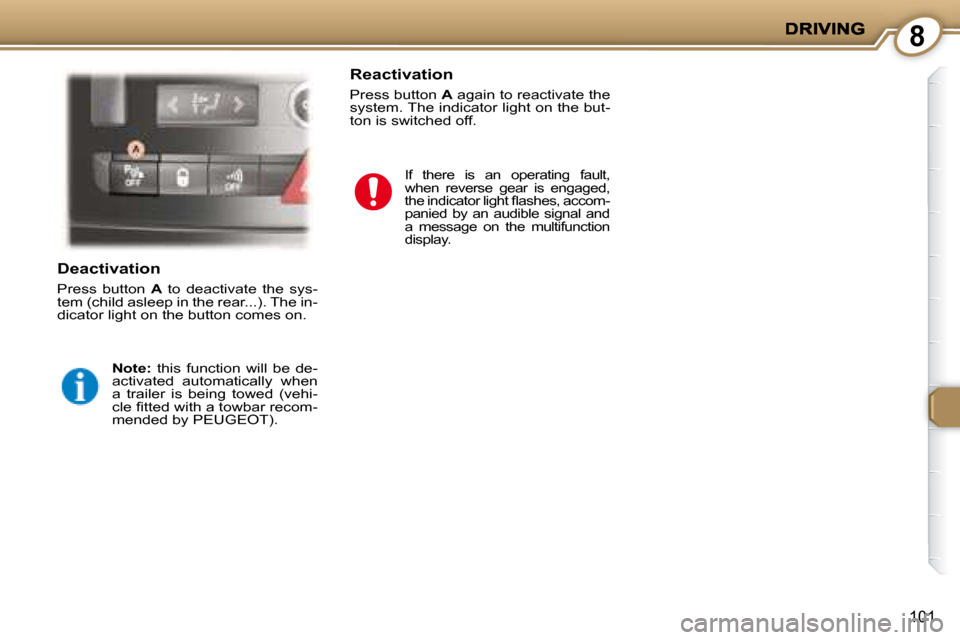
8
101
Deactivation
Press button A to deactivate the sys-
tem (child asleep in the rear...). The in-
dicator light on the button comes on.
Note: this function will be de-
activated automatically when
a trailer is being towed (vehi-
�c�l�e� �fi� �t�t�e�d� �w�i�t�h� �a� �t�o�w�b�a�r� �r�e�c�o�m�-
mended by PEUGEOT ).
Reactivation
Press button A again to reactivate the
system. The indicator light on the but-
ton is switched off.
If there is an operating fault,
when reverse gear is engaged,
�t�h�e� �i�n�d�i�c�a�t�o�r� �l�i�g�h�t� �fl� �a�s�h�e�s�,� �a�c�c�o�m�-
panied by an audible signal and
a message on the multifunction
display.
Page 113 of 211
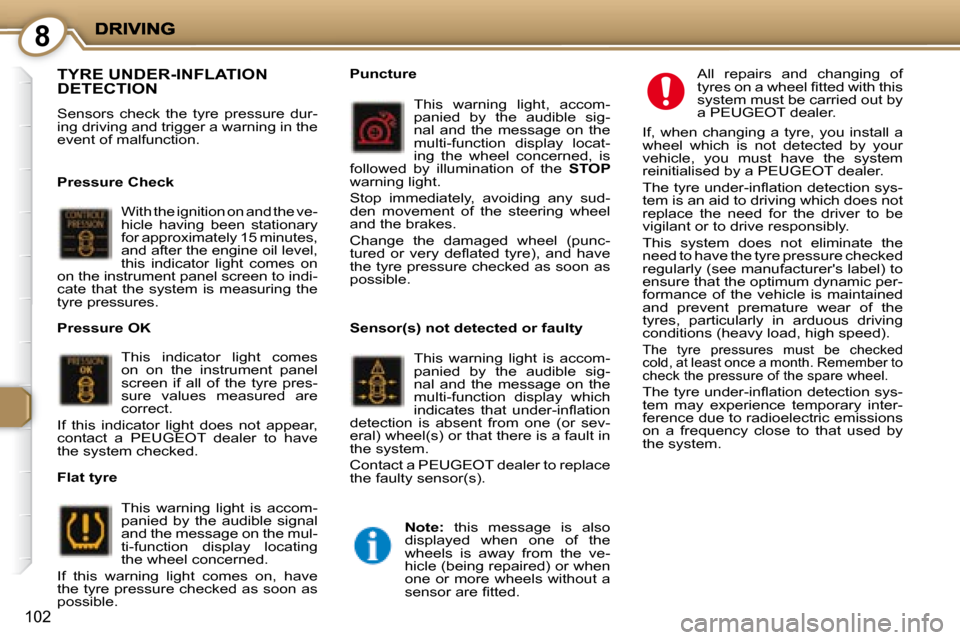
8
102
TYRE UNDER-INFLATION DETECTION
Sensors check the tyre pressure dur-
ing driving and trigger a warning in the
event of malfunction.
Pressure Check
With the ignition on and the ve-
hicle having been stationary
for approximately 15 minutes,
and after the engine oil level,
this indicator light comes on
on the instrument panel screen to indi-
cate that the system is measuring the
tyre pressures.
Pressure OK
This indicator light comes
on on the instrument panel
screen if all of the tyre pres-
sure values measured are
correct.
If this indicator light does not appear,
contact a PEUGEOT dealer to have
the system checked. Puncture
This warning light, accom-
panied by the audible sig-
nal and the message on the
multi-function display locat-
ing the wheel concerned, is
followed by illumination of the STOP
warning light.
Stop immediately, avoiding any sud-
den movement of the steering wheel
and the brakes.
Change the damaged wheel (punc-
�t�u�r�e�d� �o�r� �v�e�r�y� �d�e�fl� �a�t�e�d� �t�y�r�e�)�,� �a�n�d� �h�a�v�e�
the tyre pressure checked as soon as
possible.
Note: this message is also
displayed when one of the
wheels is away from the ve-
hicle (being repaired) or when
one or more wheels without a
�s�e�n�s�o�r� �a�r�e� �fi� �t�t�e�d�.� All repairs and changing of
�t�y�r�e�s� �o�n� �a� �w�h�e�e�l� �fi� �t�t�e�d� �w�i�t�h� �t�h�i�s�
system must be carried out by
a PEUGEOT dealer.
If, when changing a tyre, you install a
wheel which is not detected by your
vehicle, you must have the system
reinitialised by a PEUGEOT dealer.
� �T�h�e� �t�y�r�e� �u�n�d�e�r�-�i�n�fl� �a�t�i�o�n� �d�e�t�e�c�t�i�o�n� �s�y�s�-
tem is an aid to driving which does not
replace the need for the driver to be
vigilant or to drive responsibly.
This system does not eliminate the
need to have the tyre pressure checked
regularly (see manufacturer's label) to
ensure that the optimum dynamic per-
formance of the vehicle is maintained
and prevent premature wear of the
tyres, particularly in arduous driving
conditions (heavy load, high speed).
The tyre pressures must be checked
cold, at least once a month. Remember to
check the pressure of the spare wheel.
� �T�h�e� �t�y�r�e� �u�n�d�e�r�-�i�n�fl� �a�t�i�o�n� �d�e�t�e�c�t�i�o�n� �s�y�s�-
tem may experience temporary inter-
ference due to radioelectric emissions
on a frequency close to that used by
the system.
Flat tyre This warning light is accom-
panied by the audible signal
and the message on the mul-
ti-function display locating
the wheel concerned.
If this warning light comes on, have
the tyre pressure checked as soon as
possible. Sensor(s) not detected or faulty
This warning light is accom-
panied by the audible sig-
nal and the message on the
multi-function display which
�i�n�d�i�c�a�t�e�s� �t�h�a�t� �u�n�d�e�r�-�i�n�fl� �a�t�i�o�n�
detection is absent from one (or sev-
eral) wheel(s) or that there is a fault in
the system.
Contact a PEUGEOT dealer to replace
the faulty sensor(s).
Page 114 of 211
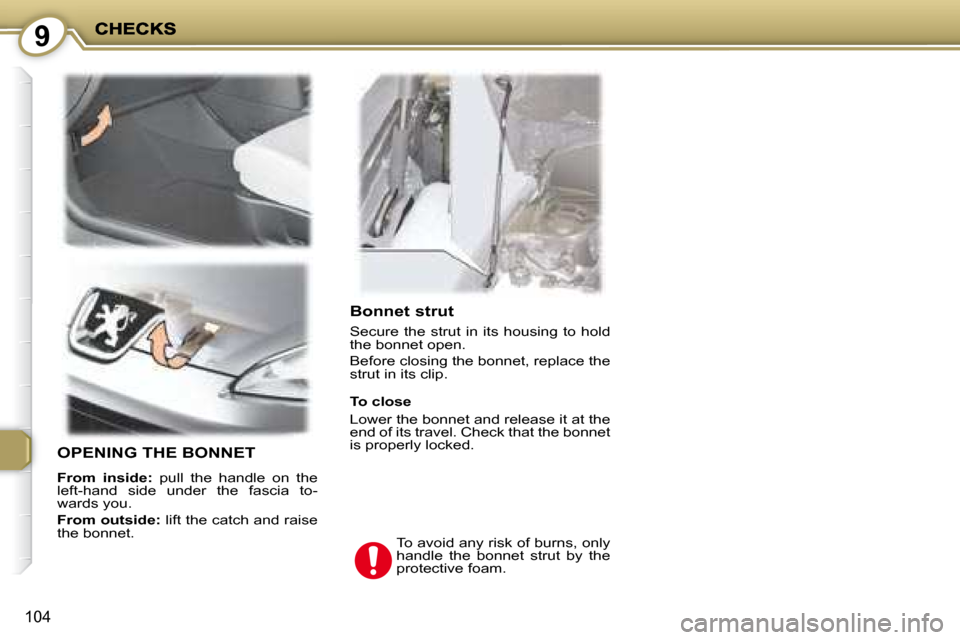
9
104
Bonnet strut
Secure the strut in its housing to hold
the bonnet open.
Before closing the bonnet, replace the
strut in its clip.
OPENING THE BONNET
From inside: pull the handle on the
left-hand side under the fascia to-
wards you.
From outside: lift the catch and raise
the bonnet. To avoid any risk of burns, only
handle the bonnet strut by the
protective foam.
To close
Lower the bonnet and release it at the
end of its travel. Check that the bonnet
is properly locked.
Page 115 of 211
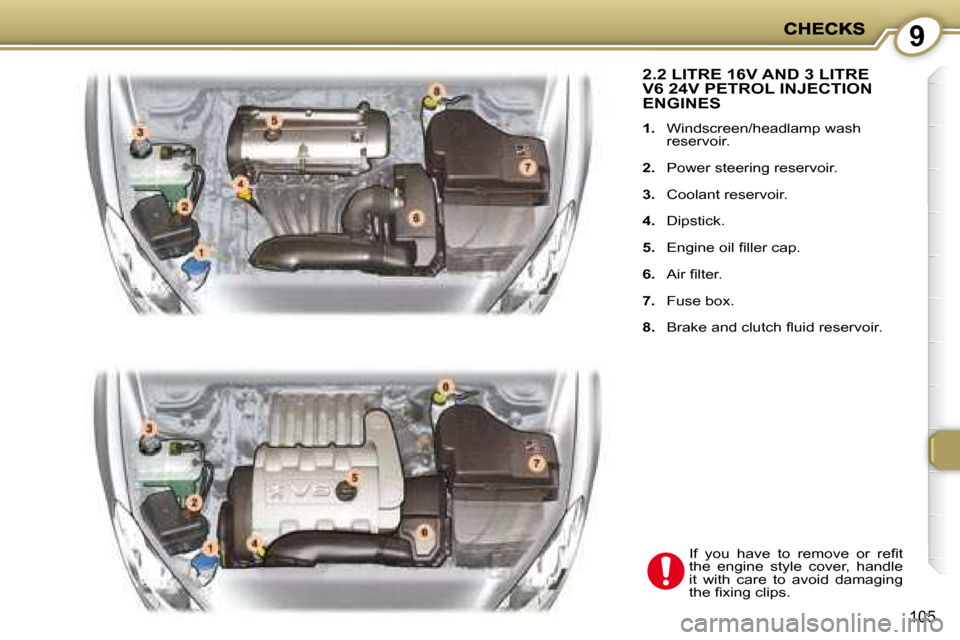
9
105
2.2 LITRE 16V AND 3 LITRE V6 24V PETROL INJECTION ENGINES
1. Windscreen/headlamp wash
reservoir.
2. Power steering reservoir.
3. Coolant reservoir.
4. Dipstick.
5. � � �E�n�g�i�n�e� �o�i�l� �fi� �l�l�e�r� �c�a�p�.�
6. � � �A�i�r� �fi� �l�t�e�r�.�
7. Fuse box.
8. � � �B�r�a�k�e� �a�n�d� �c�l�u�t�c�h� �fl� �u�i�d� �r�e�s�e�r�v�o�i�r�.� � �
�I�f� �y�o�u� �h�a�v�e� �t�o� �r�e�m�o�v�e� �o�r� �r�e�fi� �t�
the engine style cover, handle
it with care to avoid damaging
�t�h�e� �fi� �x�i�n�g� �c�l�i�p�s�.�
Page 116 of 211
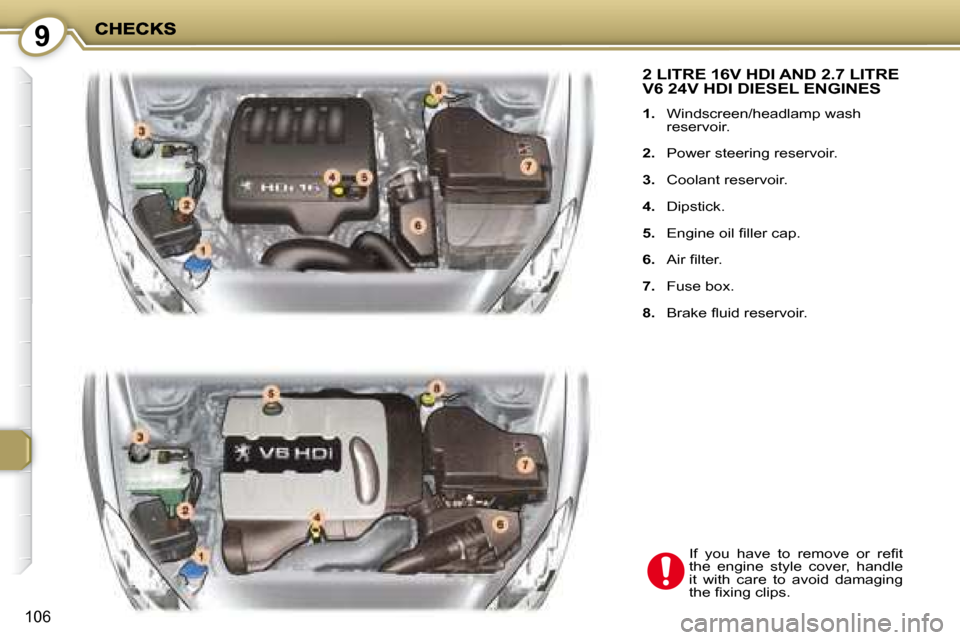
9
106
2 LITRE 16V HDI AND 2.7 LITRE V6 24V HDI DIESEL ENGINES
1. Windscreen/headlamp wash
reservoir.
2. Power steering reservoir.
3. Coolant reservoir.
4. Dipstick.
5. � � �E�n�g�i�n�e� �o�i�l� �fi� �l�l�e�r� �c�a�p�.�
6. � � �A�i�r� �fi� �l�t�e�r�.�
7. Fuse box.
8. � � �B�r�a�k�e� �fl� �u�i�d� �r�e�s�e�r�v�o�i�r�.� �
� �I�f� �y�o�u� �h�a�v�e� �t�o� �r�e�m�o�v�e� �o�r� �r�e�fi� �t�
the engine style cover, handle
it with care to avoid damaging
�t�h�e� �fi� �x�i�n�g� �c�l�i�p�s�.�
Page 117 of 211
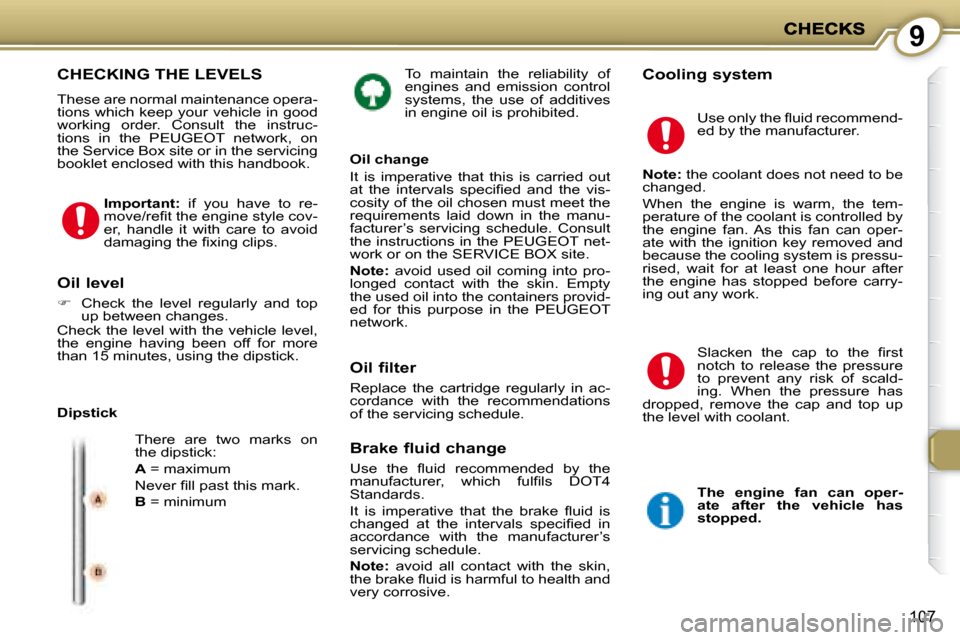
9
107
To maintain the reliability of
engines and emission control
systems, the use of additives
in engine oil is prohibited. Cooling system CHECKING THE LEVELS
These are normal maintenance opera-
tions which keep your vehicle in good
working order. Consult the instruc-
tions in the PEUGEOT network, on
the Service Box site or in the servicing
booklet enclosed with this handbook.
Dipstick There are two marks on
the dipstick:
A = maximum
� �N�e�v�e�r� �fi� �l�l� �p�a�s�t� �t�h�i�s� �m�a�r�k�.�
B = minimum
Oil level
� Check the level regularly and top
up between changes.
Check the level with the vehicle level,
the engine having been off for more
than 15 minutes, using the dipstick.
Important: if you have to re-
�m�o�v�e�/�r�e�fi� �t� �t�h�e� �e�n�g�i�n�e� �s�t�y�l�e� �c�o�v�-
er, handle it with care to avoid
�d�a�m�a�g�i�n�g� �t�h�e� �fi� �x�i�n�g� �c�l�i�p�s�.� Oil change
It is imperative that this is carried out
�a�t� �t�h�e� �i�n�t�e�r�v�a�l�s� �s�p�e�c�i�fi� �e�d� �a�n�d� �t�h�e� �v�i�s�-
cosity of the oil chosen must meet the
requirements laid down in the manu-
facturer’s servicing schedule. Consult
the instructions in the PEUGEOT net-
work or on the SERVICE BOX site.
Note: avoid used oil coming into pro-
longed contact with the skin. Empty
the used oil into the containers provid-
ed for this purpose in the PEUGEOT
network.
Oil filter
Replace the cartridge regularly in ac-
cordance with the recommendations
of the servicing schedule.
Brake fluid change
� �U�s�e� �t�h�e� �fl� �u�i�d� �r�e�c�o�m�m�e�n�d�e�d� �b�y� �t�h�e�
�m�a�n�u�f�a�c�t�u�r�e�r�,� �w�h�i�c�h� �f�u�l�fi� �l�s� �D�O�T�4�
Standards.
� �I�t� �i�s� �i�m�p�e�r�a�t�i�v�e� �t�h�a�t� �t�h�e� �b�r�a�k�e� �fl� �u�i�d� �i�s�
�c�h�a�n�g�e�d� �a�t� �t�h�e� �i�n�t�e�r�v�a�l�s� �s�p�e�c�i�fi� �e�d� �i�n�
accordance with the manufacturer’s
servicing schedule.
Note: avoid all contact with the skin,
�t�h�e� �b�r�a�k�e� �fl� �u�i�d� �i�s� �h�a�r�m�f�u�l� �t�o� �h�e�a�l�t�h� �a�n�d�
very corrosive. � �U�s�e� �o�n�l�y� �t�h�e� �fl� �u�i�d� �r�e�c�o�m�m�e�n�d�-
ed by the manufacturer.
Note: the coolant does not need to be
changed.
When the engine is warm, the tem-
perature of the coolant is controlled by
the engine fan. As this fan can oper-
ate with the ignition key removed and
because the cooling system is pressu-
rised, wait for at least one hour after
the engine has stopped before carry-
ing out any work.
� �S�l�a�c�k�e�n� �t�h�e� �c�a�p� �t�o� �t�h�e� �fi� �r�s�t�
notch to release the pressure
to prevent any risk of scald-
ing. When the pressure has
dropped, remove the cap and top up
the level with coolant.
The engine fan can oper-
ate after the vehicle has
stopped.
Page 118 of 211
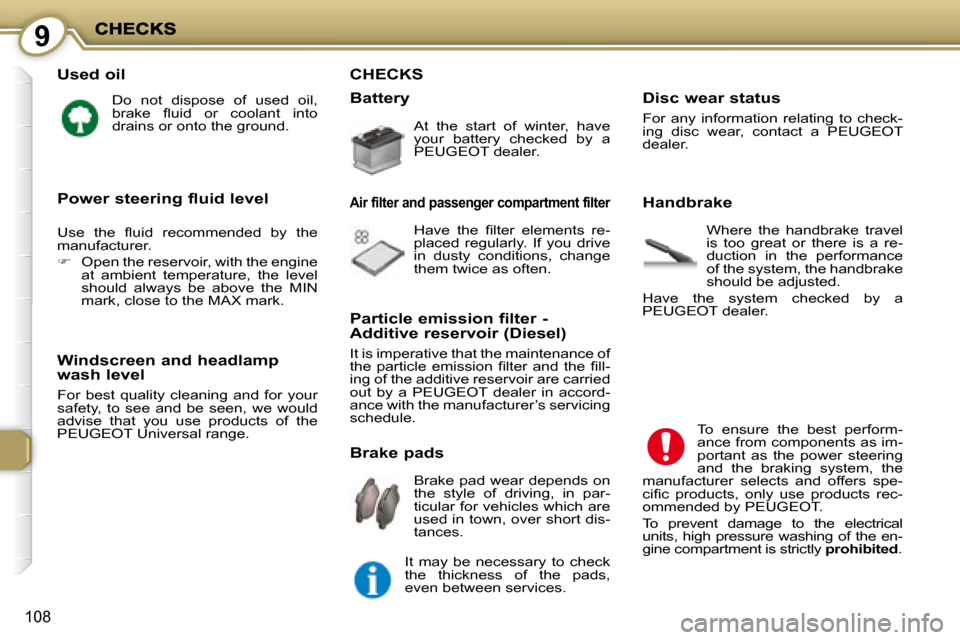
9
108
Used oil
Do not dispose of used oil,
�b�r�a�k�e� �fl� �u�i�d� �o�r� �c�o�o�l�a�n�t� �i�n�t�o�
drains or onto the ground.
Windscreen and headlamp wash level
For best quality cleaning and for your
safety, to see and be seen, we would
advise that you use products of the
PEUGEOT Universal range. At the start of winter, have
your battery checked by a
PEUGEOT dealer.
Battery
CHECKS
� �H�a�v�e� �t�h�e� �fi� �l�t�e�r� �e�l�e�m�e�n�t�s� �r�e�-
placed regularly. If you drive
in dusty conditions, change
them twice as often.
Air filter and passenger compartment filter
Brake pad wear depends on
the style of driving, in par-
ticular for vehicles which are
used in town, over short dis-
tances.
Brake pads
It may be necessary to check
the thickness of the pads,
even between services. Where the handbrake travel
is too great or there is a re-
duction in the performance
of the system, the handbrake
should be adjusted.
Have the system checked by a
PEUGEOT dealer.
Handbrake
To ensure the best perform-
ance from components as im-
portant as the power steering
and the braking system, the
manufacturer selects and offers spe-
�c�i�fi� �c� �p�r�o�d�u�c�t�s�,� �o�n�l�y� �u�s�e� �p�r�o�d�u�c�t�s� �r�e�c�-
ommended by PEUGEOT .
To prevent damage to the electrical
units, high pressure washing of the en-
gine compartment is strictly prohibited .
� � �U�s�e� �t�h�e� �fl� �u�i�d� �r�e�c�o�m�m�e�n�d�e�d� �b�y� �t�h�e�
manufacturer.
� Open the reservoir, with the engine
at ambient temperature, the level
should always be above the MIN
mark, close to the MAX mark.
Particle emission filter - Additive reservoir (Diesel)
It is imperative that the maintenance of
�t�h�e� �p�a�r�t�i�c�l�e� �e�m�i�s�s�i�o�n� �fi� �l�t�e�r� �a�n�d� �t�h�e� �fi� �l�l�-
ing of the additive reservoir are carried
out by a PEUGEOT dealer in accord-
ance with the manufacturer’s servicing
schedule.
Disc wear status
For any information relating to check-
ing disc wear, contact a PEUGEOT
dealer.
Power steering fluid level
Page 119 of 211
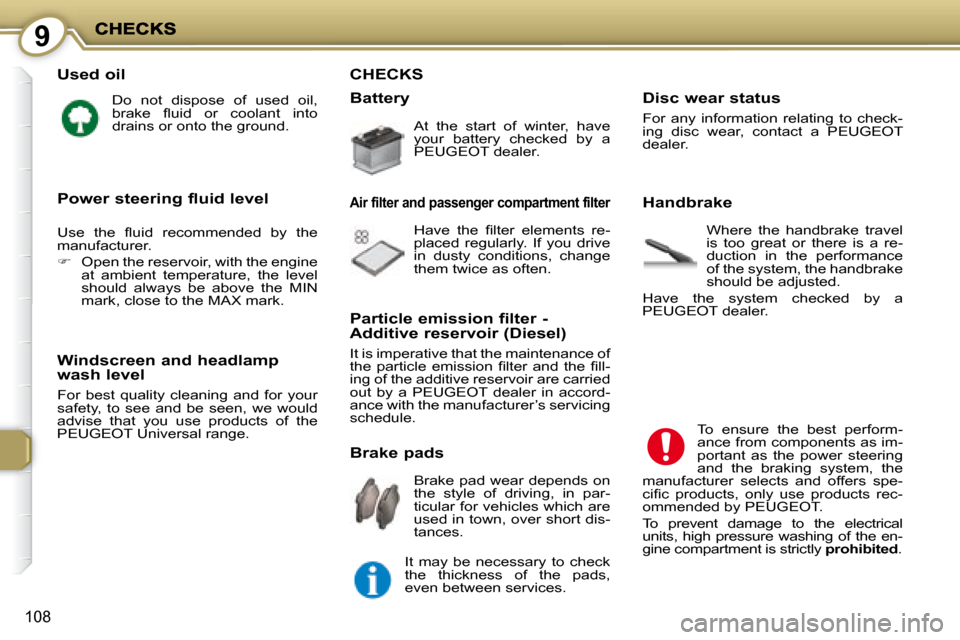
9
108
Used oil
Do not dispose of used oil,
�b�r�a�k�e� �fl� �u�i�d� �o�r� �c�o�o�l�a�n�t� �i�n�t�o�
drains or onto the ground.
Windscreen and headlamp wash level
For best quality cleaning and for your
safety, to see and be seen, we would
advise that you use products of the
PEUGEOT Universal range. At the start of winter, have
your battery checked by a
PEUGEOT dealer.
Battery
CHECKS
� �H�a�v�e� �t�h�e� �fi� �l�t�e�r� �e�l�e�m�e�n�t�s� �r�e�-
placed regularly. If you drive
in dusty conditions, change
them twice as often.
Air filter and passenger compartment filter
Brake pad wear depends on
the style of driving, in par-
ticular for vehicles which are
used in town, over short dis-
tances.
Brake pads
It may be necessary to check
the thickness of the pads,
even between services. Where the handbrake travel
is too great or there is a re-
duction in the performance
of the system, the handbrake
should be adjusted.
Have the system checked by a
PEUGEOT dealer.
Handbrake
To ensure the best perform-
ance from components as im-
portant as the power steering
and the braking system, the
manufacturer selects and offers spe-
�c�i�fi� �c� �p�r�o�d�u�c�t�s�,� �o�n�l�y� �u�s�e� �p�r�o�d�u�c�t�s� �r�e�c�-
ommended by PEUGEOT .
To prevent damage to the electrical
units, high pressure washing of the en-
gine compartment is strictly prohibited .
� � �U�s�e� �t�h�e� �fl� �u�i�d� �r�e�c�o�m�m�e�n�d�e�d� �b�y� �t�h�e�
manufacturer.
� Open the reservoir, with the engine
at ambient temperature, the level
should always be above the MIN
mark, close to the MAX mark.
Particle emission filter - Additive reservoir (Diesel)
It is imperative that the maintenance of
�t�h�e� �p�a�r�t�i�c�l�e� �e�m�i�s�s�i�o�n� �fi� �l�t�e�r� �a�n�d� �t�h�e� �fi� �l�l�-
ing of the additive reservoir are carried
out by a PEUGEOT dealer in accord-
ance with the manufacturer’s servicing
schedule.
Disc wear status
For any information relating to check-
ing disc wear, contact a PEUGEOT
dealer.
Power steering fluid level
Page 120 of 211
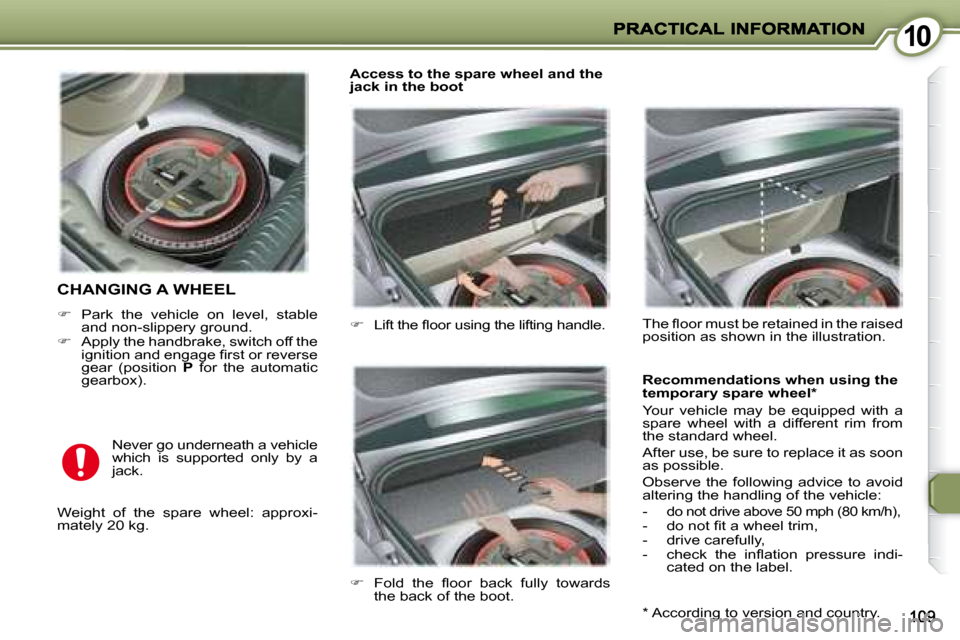
1010
CHANGING A WHEEL
� Park the vehicle on level, stable
and non-slippery ground.
� Apply the handbrake, switch off the
�i�g�n�i�t�i�o�n� �a�n�d� �e�n�g�a�g�e� �fi� �r�s�t� �o�r� �r�e�v�e�r�s�e�
gear (position P for the automatic
gearbox).
Weight of the spare wheel: approxi-
mately 20 kg. Never go underneath a vehicle
which is supported only by a
jack.
� � � �L�i�f�t� �t�h�e� �fl� �o�o�r� �u�s�i�n�g� �t�h�e� �l�i�f�t�i�n�g� �h�a�n�d�l�e�.�
� � � �F�o�l�d� �t�h�e� �fl� �o�o�r� �b�a�c�k� �f�u�l�l�y� �t�o�w�a�r�d�s�
the back of the boot.
Access to the spare wheel and the
jack in the boot
� �T�h�e� �fl� �o�o�r� �m�u�s�t� �b�e� �r�e�t�a�i�n�e�d� �i�n� �t�h�e� �r�a�i�s�e�d�
position as shown in the illustration.
Recommendations when using the
temporary spare wheel *
Your vehicle may be equipped with a
spare wheel with a different rim from
the standard wheel.
After use, be sure to replace it as soon
as possible.
Observe the following advice to avoid
altering the handling of the vehicle:
-
do not drive above 50 mph (80 km/h), � � �-� � �d�o� �n�o�t� �fi� �t� �a� �w�h�e�e�l� �t�r�i�m�,�
- drive carefully,
� � �-� � �c�h�e�c�k� �t�h�e� �i�n�fl� �a�t�i�o�n� �p�r�e�s�s�u�r�e� �i�n�d�i�-cated on the label.
* According to version and country.